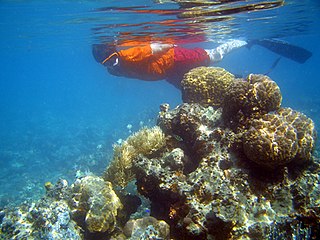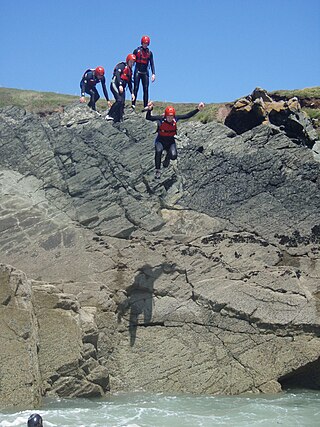
Snorkeling is the practice of swimming face down on or through a body of water while breathing the ambient air through a shaped tube called a snorkel, usually with swimming goggles or a diving mask, and swimfins. In cooler waters, a wetsuit may also be worn. The snorkel may be an independent item or integrated with the mask. The use of this equipment allows the snorkeler to observe the underwater environment for extended periods with relatively little effort, and to breathe while face-down at the surface.

Freediving, free-diving, free diving, breath-hold diving, or skin diving, is a mode of underwater diving that relies on breath-holding until resurfacing rather than the use of breathing apparatus such as scuba gear.

Spearfishing is fishing using handheld elongated, sharp-pointed tools such as a spear, gig, or harpoon, to impale the fish in the body. It was one of the earliest fishing techniques used by mankind, and has been deployed in artisanal fishing throughout the world for millennia. Early civilizations were familiar with the custom of spearing fish from rivers and streams using sharpened sticks.

A diving suit is a garment or device designed to protect a diver from the underwater environment. A diving suit may also incorporate a breathing gas supply, but in most cases the term applies only to the environmental protective covering worn by the diver. The breathing gas supply is usually referred to separately. There is no generic term for the combination of suit and breathing apparatus alone. It is generally referred to as diving equipment or dive gear along with any other equipment necessary for the dive.

Diving activities are the things people do while diving underwater. People may dive for various reasons, both personal and professional. While a newly qualified recreational diver may dive purely for the experience of diving, most divers have some additional reason for being underwater. Recreational diving is purely for enjoyment and has several specialisations and technical disciplines to provide more scope for varied activities for which specialist training can be offered, such as cave diving, wreck diving, ice diving and deep diving. Several underwater sports are available for exercise and competition.

Recreational diving or sport diving is diving for the purpose of leisure and enjoyment, usually when using scuba equipment. The term "recreational diving" may also be used in contradistinction to "technical diving", a more demanding aspect of recreational diving which requires more training and experience to develop the competence to reliably manage more complex equipment in the more hazardous conditions associated with the disciplines. Breath-hold diving for recreation also fits into the broader scope of the term, but this article covers the commonly used meaning of scuba diving for recreational purposes, where the diver is not constrained from making a direct near-vertical ascent to the surface at any point during the dive, and risk is considered low.
Audrey Mestre was a French world record-setting freediver.

Coasteering is movement along the intertidal zone of a rocky coastline on foot or by swimming, without the aid of boats, surf boards or other craft.

Cliff jumping is the leaping off a cliff edge, usually into a body of water, as a form of sport. It may be done as part of the sport of coastal exploration or as a standalone activity. Particular variations on cliff jumping may specify the angle of entry into the water or the inclusion or exclusion of human-made platforms or other equipment. Cliff diving and its close relative tombstoning are specific to water landing. Cliff jumping with the use of a parachute would typically be classified as a form of BASE jumping.

Cressi is one of the largest manufacturers of water sports equipment in the world serving the scuba dive, snorkel and swim industries. The company's five divisions cover four markets—scuba diving, snorkeling, spearfishing, and swimming. Cressi maintains a significant presence in each major economic region around the globe and delivers some 300 distinct products to more than 90 countries. Formerly Cressi-Sub, the Italian company was founded by two brothers, Egidio and Nanni Cressi in 1946 in Genoa, Italy. Still family owned and operated, the company is headed today by Antonio Cressi and its headquarters and manufacturing facilities remain in Genoa.

A snorkel is a device used for breathing atmospheric air when the wearer's head is face downwards in the water with the mouth and the nose submerged. It may be either a separate unit, or integrated into a swimming or diving mask. The integrated version is only suitable for surface snorkeling, while the separate device may also be used for underwater activities such as spearfishing, freediving, finswimming, underwater hockey, underwater rugby and for surface breathing while wearing scuba equipment. A standard snorkel is a curved tube with a shape usually resembling the letter "L" or "J", fitted with a mouthpiece at the lower end and made from plastic, synthetic elastomers, rubber, or light metal. The snorkel may have a loop or a clip to attach it to the head strap of the diving mask or swimming goggles, or may be tucked between the mask-strap and the head. Some snorkels are fitted with a float valve at the top to prevent flooding if the top opening is immersed, and some are fitted with a water trap and purge valve, intended for draining water from the tube.
Underwater sports is a group of competitive sports using one or a combination of the following underwater diving techniques - breath-hold, snorkelling or scuba, usually including the use of equipment such as diving masks and fins. These sports are conducted in the natural environment at sites such as open water and sheltered or confined water such as lakes and in artificial aquatic environments such as swimming pools. Underwater sports include the following - aquathlon, finswimming, freediving, spearfishing, sport diving, underwater football, underwater hockey, underwater ice hockey, underwater orienteering, underwater photography, underwater rugby, underwater target shooting and underwater video.

Outdoor recreation or outdoor activity refers to recreation done outside, most commonly in natural settings. The activities that encompass outdoor recreation vary depending on the physical environment they are being carried out in. These activities can include fishing, hunting, backpacking, walking and horseback riding — and can be completed individually or collectively. Outdoor recreation is a broad concept that encompasses a varying range of activities and landscapes.

Diving equipment, or underwater diving equipment, is equipment used by underwater divers to make diving activities possible, easier, safer and/or more comfortable. This may be equipment primarily intended for this purpose, or equipment intended for other purposes which is found to be suitable for diving use.

Confédération Mondiale des Activités Subaquatiques (CMAS) is an international federation that represents underwater activities in underwater sport and underwater sciences, and oversees an international system of recreational snorkel and scuba diver training and recognition. It is also known by its English name, the World Underwater Federation, and its Spanish name, Confederación Mundial De Actividades Subacuáticas. Its foundation in Monaco during January 1959 makes it one of the world's oldest underwater diving organisations.
Sport diving is an underwater sport that uses recreational open circuit scuba diving equipment and consists of a set of individual and team events conducted in a swimming pool that test the competitors' competency in recreational scuba diving techniques. The sport was developed in Spain during the late 1990s and is currently played mainly in Europe. It is known as Plongée Sportive en Piscine in French and as Buceo De Competición in Spanish.

The following outline is provided as an overview of and topical guide to underwater diving:

The following index is provided as an overview of and topical guide to underwater diving:















